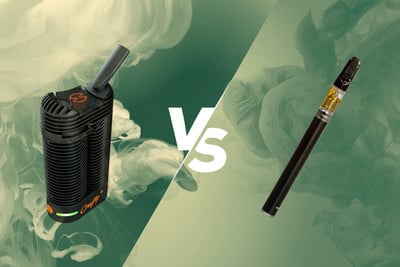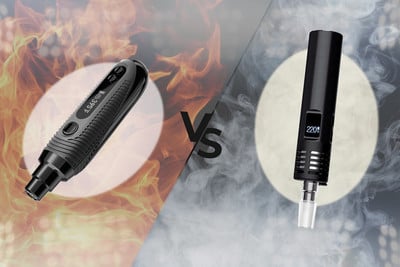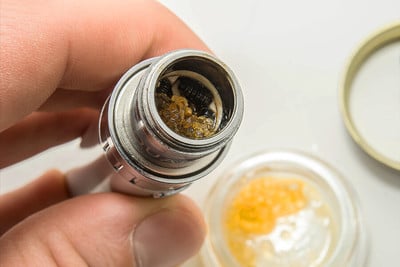.

Do Vapes Smell And What Can You Do About It?
Vaping is better than smoking if you're concerned about the telltale smell of weed. Still, it's not 100% effective. Keep reading to learn all about the scent emitted by vaping cannabis and what to do about it.
Weed is a smelly substance, and this pungent aroma can draw unwanted attention. If you vape, understanding how to deal with the aroma is crucial, especially for those seeking discretion or respecting social norms (even if you disagree with them).
With potentially fewer adverse health effects and its enhancement of flavour and effects, more and more people are turning to vaping as a means of cannabis consumption. In this article, we look at how much vapes really smell and how to avoid or disguise the aroma.
Contents:
What's the Difference Between Smoking and Vaping Marijuana?
There are several differences between smoking and vaping weed. But here, we'll focus on those related to smell.
Smoking burns or combusts cannabis, producing a distinct, pungent smoke that lingers and sticks to clothes, furniture, and walls. Vaping, on the other hand, heats cannabis to release its active ingredients without combustion, resulting in a vapour that is less dense and has a milder scent. Vaping technology reduces the smell by avoiding the combustion of plant material, so it's definitely a more discrete option for consuming cannabis.
.jpg)

Does Vaping Produce a Weed Smell?
Vapour from vaping does have a smell, but it is significantly less potent and pervasive than smoke from burning weed. The characteristics of vapour—its reduced density and temperature—mean that it dissipates more quickly and doesn't stick to surfaces in the same insidious way smoke does.
The duration and detectability of the smell from vaping depends on various factors, including the environment and the device used. However, generally, the scent of vaping does not linger as long or as strongly as that of smoking.
Which Elements Affect Smell?
Several factors determine the scent associated with vaping, each contributing to the overall aroma intensity and duration. Understanding these elements can help you to reduce the smell of vaping, ensuring a more discreet experience.
Ventilation
A well-ventilated area ensures that vapour does not accumulate or linger, allowing the smell to dissipate more quickly than in poorly ventilated spaces. Opening windows, using fans, or vaping in open spaces can significantly reduce the presence and persistence of vapour smell. If you're being really cautious, you could vape in the bathroom and then cleanse the room with the humidity of a super hot shower. Still, most of the time, this isn't necessary.
Strain
Your strain choice is another factor affecting smell. Different strains have unique terpene profiles which define their distinctive scents. Some strains may emit a stronger, more earthy aroma, while others are more floral in nature. Still, to the untrained nose, most cannabis strains smell simply of weed, so the focus on eliminating all odours remains the same.
Heating Method
The technology behind the vaporiser, especially the heating method, plays a critical role in the scent's prominence. There are two primary heating methods used in vaporisers: conduction and convection.
Conduction vaporisers work by directly heating the cannabis material, making contact with a heated surface. This method can sometimes lead to uneven heating and a slightly more pronounced smell, as some parts of the material may get hotter than others, potentially causing some collateral combustion.
Convection vaporisers, on the other hand, heat the air around the material, ensuring that the cannabis is heated more evenly and efficiently. This method is considered superior for flavour preservation and produces a less noticeable smell. Since convection heating reduces the risk of combustion, it also decreases the likelihood of producing a strong, lingering odour.
.jpg)
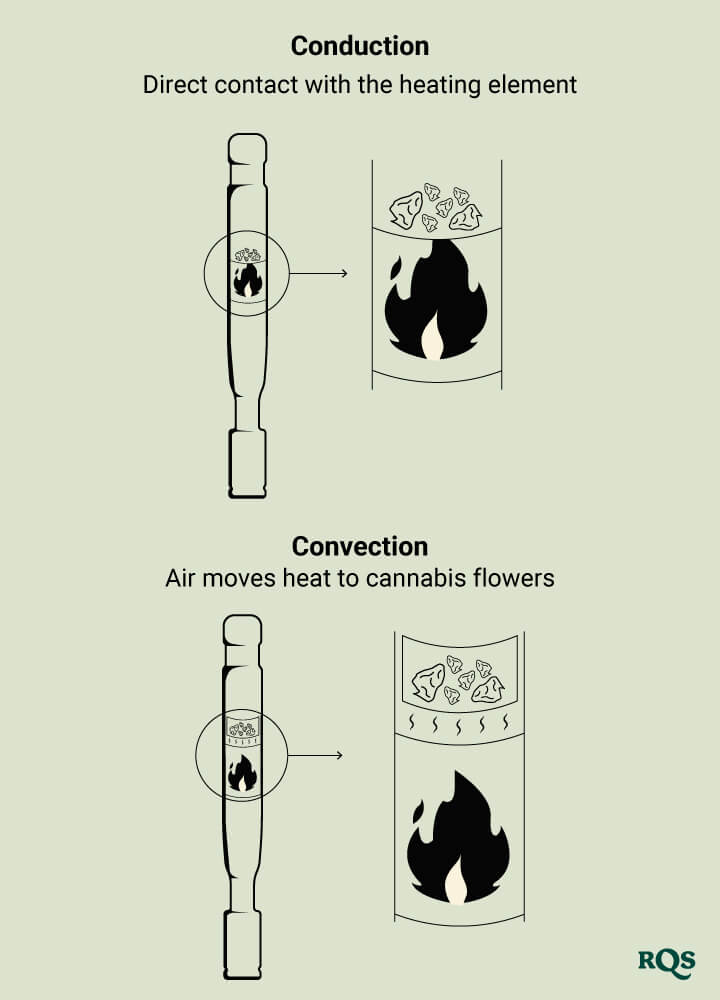
How Different Devices Produce Smell
The scent produced by vaping can vary widely depending on the type of device used. As such, understanding these differences can help you choose the right vaporiser for your needs.
Dry Herb Vaporisers
These devices vaporise dried cannabis flowers. As they heat up the dry herb directly, the natural terpenes and cannabinoids in the flower are released, producing that telltale scent. The smell from dry herb vaporisers can be more noticeable compared to other forms of vaping because it involves a complete array of aromatic compounds. However, since the herb is vaporised rather than combusted, the scent is still less pungent and dissipates more quickly than smoke.
Wax/Dab Pens
These devices are used for vaping concentrates like wax, shatter, or resin. When vaped, the intense heating of cannabis concentrates results in a less pronounced scent compared to dry herb vaporisers. This is partly because the volume of material is smaller, and the extracted form lacks the plant matter that contributes to the stronger smell. Additionally, the high concentration of active ingredients leads to a more efficient consumption process, reducing the amount of vapour needed and, consequently, the scent produced.
Vape Pens and Oil Vapes
These devices are typically the most discreet option when it comes to scent. They use cartridges filled with cannabis oil, which can include pure cannabinoids like THC or CBD, mixed with a carrier oil and sometimes flavourings. Fortunately, adding flavourings can mask the cannabis scent, making it less recognisable.
Moreover, the oils used in these cartridges are refined and purified, further reducing the typical weed smell. The vapour from these devices dissipates rapidly, leaving little to no cannabis odour in the air. This makes THC/CBD oil vapes an attractive option for users seeking the utmost discretion.
.jpg)
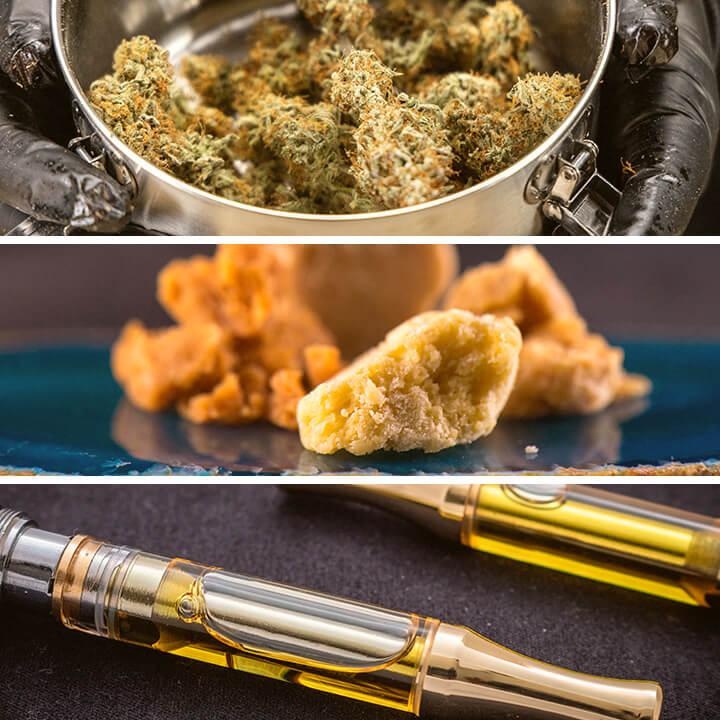
How to Reduce Smell When Vaping
For users looking to maintain discretion, there are several tips to help you vape without leaving a lingering smell:
- Use lower temperature settings to reduce the intensity of the vapour's smell
- Choose convection heating over conduction if possible
- Vape in well-ventilated areas to allow the odour to dissipate more quickly
- Opt for devices and materials (like oils and concentrates) that are known for producing less aroma
- Using air purifiers or odour eliminators
- Keeping the area ventilated during and after vaping
- Storing and cleaning vaping devices and materials properly
- Use breath mints and wash hands and face to remove the scent from yourself
Vaping: A Good Option if Olfactory Secrecy is Key!
While vaping weed does produce a scent, it is significantly less conspicuous and persistent than that of smoke, which can really linger, sticking to walls, furniture, hair and clothes. Stealthy vaping requires you to select the appropriate device, understand how different factors affect the smell, and find ways to manage and minimise its presence. In general, though, using a vape pen or dry herb vaporiser is a much better bet than smoking if smell is a concern.


























